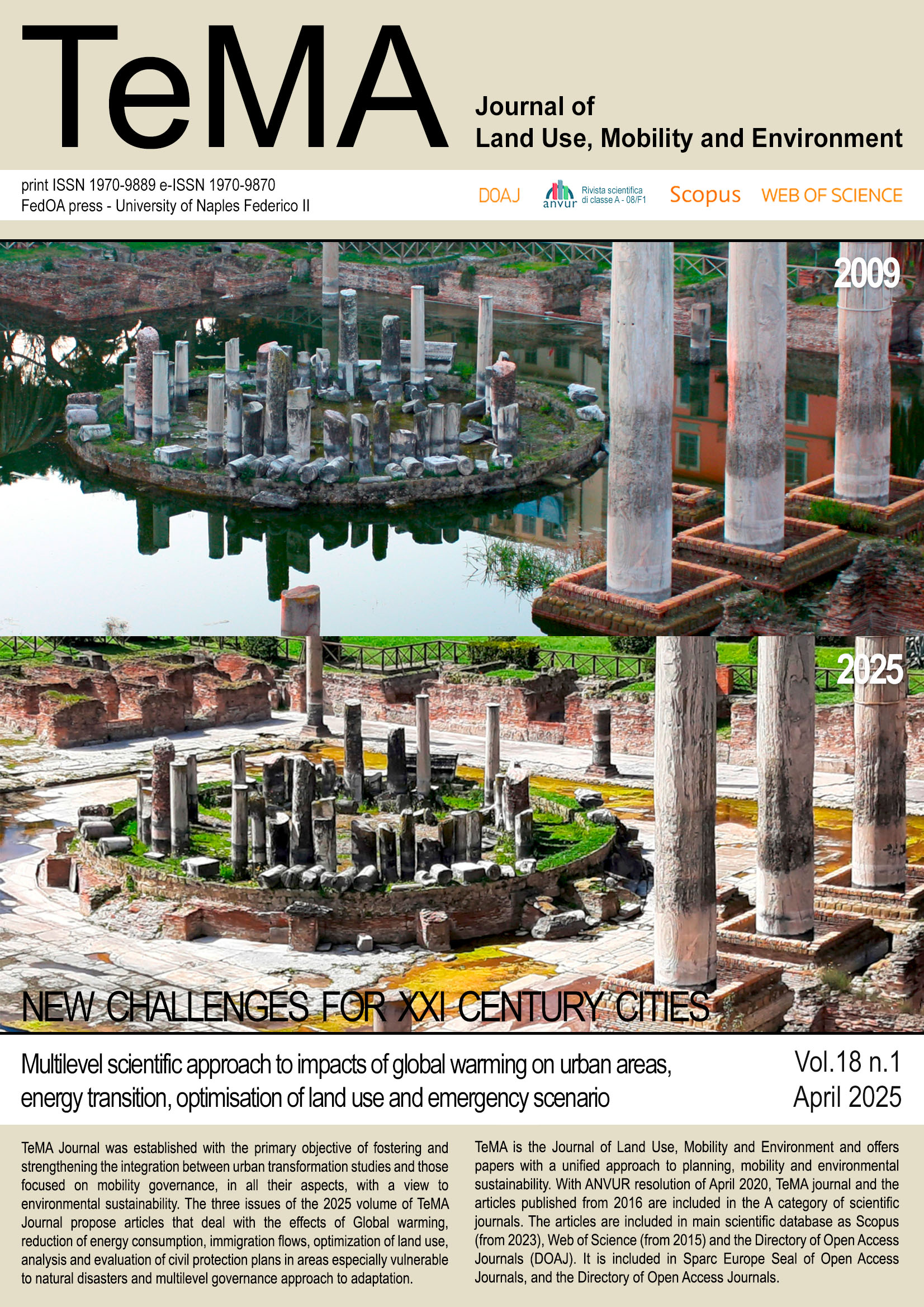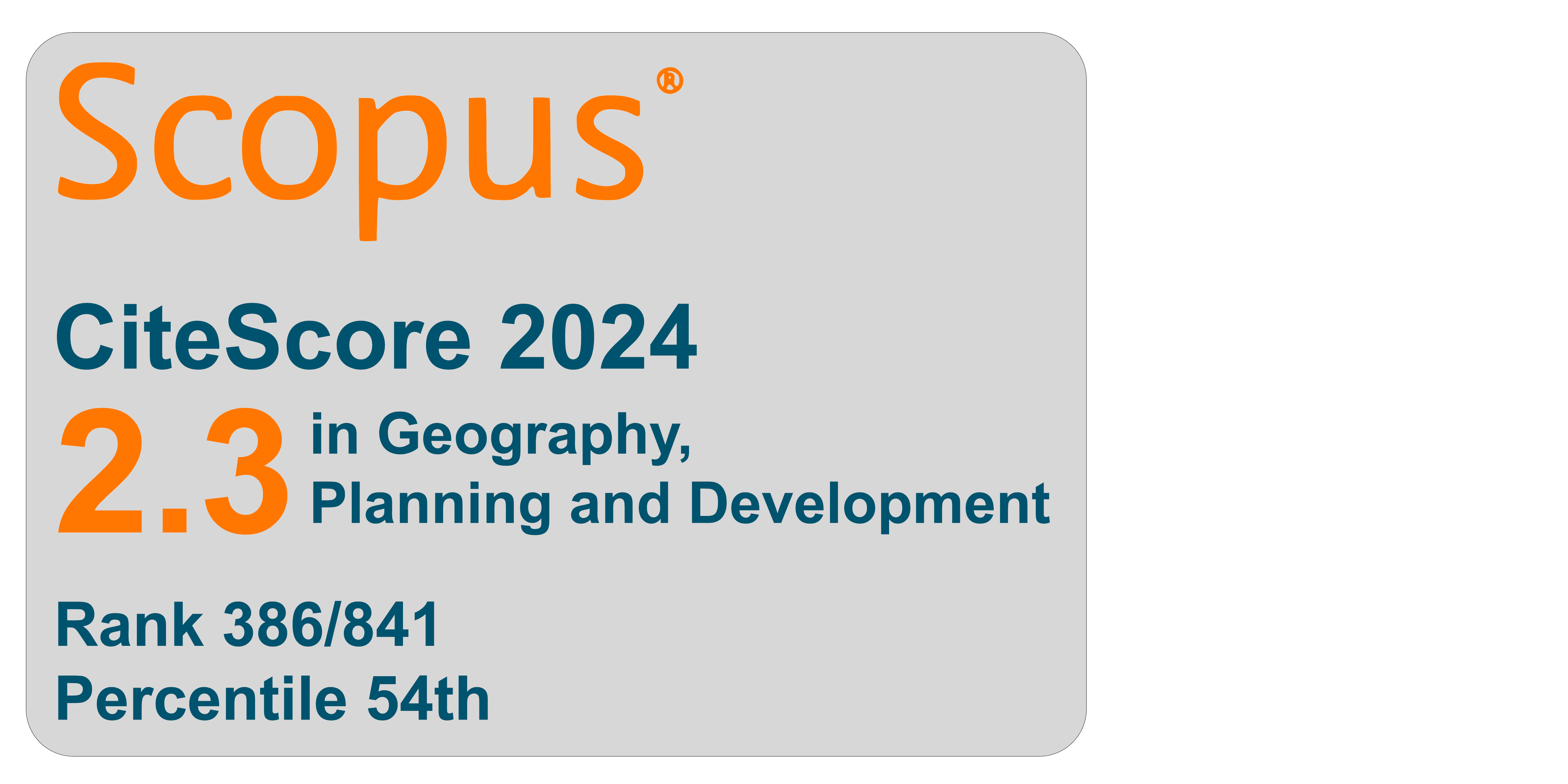Exploring open and green space characteristics for climate change adaptation: a focus on the urban heat island
DOI:
https://doi.org/10.6093/1970-9870/11636Keywords:
Green Spaces, Open Spaces, literature review, Open Space; Green Areas; Literature Review; Climate Change Adaptation; UHI.Abstract
Starting from the relationship between urban planning and mobility management, TeMA has gradually expanded the view of the covered topics, always remaining in the groove of rigorous scientific in-depth analysis. This section of the Journal, Review Notes, is the expression of continuously updating emerging topics concerning relationships between urban planning, mobility, and environment, through a collection of short scientific papers written by young researchers. The Review Notes are made of five parts. Each section examines a specific aspect of the broader information storage within the main interests of TeMA Journal. In particular, the Urban planning literature review section presents recent books and journals on selected topics and issues within the global scientific panorama.
For the first issue of TeMA Journal volume no. 18, this section provides a comprehensive overview of the challenges and solutions related to the role of open and green spaces in climate change adaptation, with particular attention to the urban heat island effect. Using a variety of scientific sources and practical resources, this contribution aims to identify the key characteristics of these spaces that can influence adaptation strategies, examining the solutions proposed in the scientific literature, specifically in books, journals, and reports.
Downloads
References
Bai, X., Yu, Z., Wang, B., Zhang, Y., Zhou, S., Sha, X., Li, S., Yao, X. & Geng, X. (2024). Quantifying threshold and scale response of urban air and surface temperature to surrounding landscapes under extreme heat, Building and Environment, 247, p. 111029. https://doi.org/10.1016/j.buildenv.2023.111029
Bouketta, S. (2023). Urban Cool Island as a sustainable passive cooling strategy of urban spaces under summer conditions in Mediterranean climate. Sustainable Cities and Society, 99, 104956. https://doi.org/10.1016/j.scs.2023.104956
Bowler, D. E., Buyung-Ali, L., Knight, T. M. & Pullin, A. S. (2010). Urban greening to cool towns and cities: A systematic review of the empirical evidence. Landscape and Urban Planning, 97 (3), 147–155. https://doi.org/10.1016/j.landurbplan.2010.05.006
Carpentieri, G., Zucaro, F. and Guida, C. (2023) ‘Urban energy consumption in the city of Naples (Italy): A geographically weighted regression approach’, Resilient Horizons: Building Sustainable Environments for Climate Adaptation and Health, 93–104. https://doi.org/10.1007/978-3-031-46109-5_8
Carpentieri, G., Gargiulo, C., Stiuso, T. & Zucaro, F. (2024). Greening and cooling urban areas: the Open Space System contribution for energy saving and climate change adaptation. In Lecture notes in computer science, 412–429. https://doi.org/10.1007/978-3-031-65273-8_27
Cruz, J. A., Blanco, A. C., Garcia, J. J., Santos, J. A. & Moscoso, A. D. (2021). Evaluation of the cooling effect of green and blue spaces on urban microclimate through numerical simulation: A case study of Iloilo River Esplanade, 74. Philip-pines: Sustainable Cities and Society, Article 103184. https://doi.org/10.1016/j.scs.2021.103184
Das, M., Das, A. & Momin, S. (2022). Quantifying the cooling effect of urban green space: A case from urban parks in a tropical mega metropolitan area (In-dia). Sustainable Cities and Society, 87, 104062. https://doi.org/10.1016/j.scs.2022.104062
Gargiulo C. & Zucaro F. (2023). A Method Proposal to Adapt Urban Open-Built and Green Spaces to Climate Change. Sustainability, 15 (10):8111. https://doi.org/10.3390/su15108111
Gargiulo, C. & Zucaro, F., (2020). Greening networks for smart and resilient cities: From methodology to application in densely built urban Contexts. Archivio di Studi Urbani e Regionali, 130-148. https://doi.org/10.3280/asur2020-127-s1008.
Gunawardena, K., Wells, M. & Kershaw, T. (2017). Utilising green and bluespace to mitigate urban heat island intensity. The Science of the Total Environment, 584–585, 1040–1055. https://doi.org/10.1016/j.scitotenv.2017.01.158
Harlan, S. L., Brazel, A. J., Prashad, L., Stefanov, W. L. & Larsen, L. (2006). Neighborhood microclimates and vulnerability to heat stress. Social Science & Medicine, 63(11), 2847–2863. https://doi.org/10.1016/j.socscimed.2006.07.030
Massaro, E., Schifanella, R., Piccardo, M. et al. Spatially-optimized urban greening for reduction of population exposure to land surface temperature extremes. Nat Commun 14, 2903 (2023). https://doi.org/10.1038/s41467-023-38596-1
Nimac, I., Bulić, I. H. & Žuvela‐Aloise, M. (2022). The contribution of urbanisa-tion and climate conditions to increased urban heat load in Zagreb (Croatia) since the 1960s. Urban Climate, 46, 101343. https://doi.org/10.1016/j.uclim.2022.101343
Patle, S. & Ghuge, V. V. (2024). Urban fragmentation approach for assessing thermal environment dynamics: A case study of semi-arid city from a comfort perspective. Urban Climate, 53, 101784. https://doi.org/10.1016/j.uclim.2023.101784
Pigliautile, I., D’Eramo, S. & Pisello, A. L. (2021). Intra-urban microclimate map-ping for citizens’ wellbeing: Novel wearable sensing techniques and automatized data-processing. Journal of Cleaner Production, 279, 123748. https://doi.org/10.1016/j.jclepro.2020.123748
Rajagopalan, P., Lim, K. C. & Jamei, E. (2014). Urban heat island and wind flow characteristics of a tropical city. Solar Energy, 107, 159–170. https://doi.org/10.1016/j.solener.2014.05.042
Shen, Y., Lin, Y., Cheah, W., Lin, J., Li, X. & Li, Y. (2022). Influences and path-ways of urban form and lifestyle on carbon emission reduction. Urban Climate, 46, 101325. https://doi.org/10.1016/j.uclim.2022.101325
Wang, M. & Gou, Z. (2024). Gaussian Mixture Model based classification for analyzing longitudinal outdoor thermal environment data to evaluate comfort conditions in urban open spaces. Urban Climate, 53, 101792. https://doi.org/10.1016/j.uclim.2023.101792
Wang, M., Wang, W. & Wu, L. (2022). Application of a new grey multivariate forecasting model in the forecasting of energy consumption in 7 regions of China. Energy, 243, 123024. https://doi.org/10.1016/j.energy.2021.123024
Weilnhammer, V., Schmid, J., Mittermeier, I., Schreiber, F., Jiang, L., Pastuhovic, V., Herr, C. & Heinze, S. (2021). Extreme weather events in europe and their health consequences - A systematic review. International Journal of Hygiene and Environmental Health, 233, 113688. https://doi.org/10.1016/j.ijheh.2021.113688
Zhang, Q., Zhou, D., Xu, D. & Rogora, A. (2022). Correlation between cooling effect of green space and surrounding urban spatial form: Evidence from 36 urban green spaces. Building and Environment, 222, 109375. https://doi.org/10.1016/j.buildenv.2022.109375
Downloads
Published
How to Cite
Issue
Section
License
Copyright (c) 2025 TeMA - Journal of Land Use, Mobility and Environment

This work is licensed under a Creative Commons Attribution-NonCommercial 4.0 International License.



